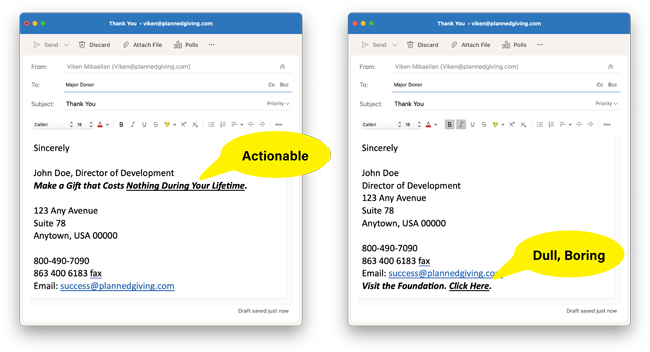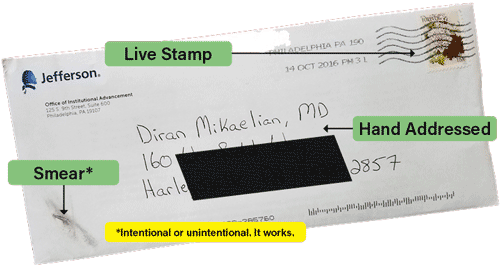Planned gifts can get complicated. Marketing them shouldn’t be. That’s why we created this simple-to-follow, easy-to-implement planned giving marketing guide.
These are tips you can use today. To get started, you’ll need to do three things:
Ready? Let’s see what these strategies and marketing tips are and learn how to use them.
So you have a limited budget but need to do some serious outreach. Reach out to your donors using your existing internal media first. These existing internal resources are your gold mine to get your message heard.
This is true for all nonprofits, from the large state university to the small hometown hospice. And this type of marketing costs you nothing. Therefore, make sure you have a planned giving message in your:
What to say? Begin with a small display ad and short elevator pitches wherever you can squeeze them. (“A gift that costs you nothing during your lifetime.”)
Your direct mail is beginning to look like junk mail.
Sorry, but it is. No matter how creative you get, no matter how hard you try to get your juices flowing, your mailers are still junk mail… to your prospects, that is.
Guess what? Junk Mail works.
Avoid being too critical of your work or trying to ensure each and every piece you send out is perfect. Nothing is perfect. You get opinions and advice, and you re-write stuff 20 times over until it is “right.” Then, you give it to a tenured professor who knows nothing about marketing, and he re-writes it in perfect English until it’s vanilla. You finally mail it… after you’ve blown three deadlines and missed phone calls from eight prospects.
Nothing happens. Worse? Not even a complaint. If you send out 10,000 planned giving brochures and do not hear at least 100 complaints, your mailers are going right into the trash. Sorry for the honesty, but it’s true.
Two things you should do:
Your boss or someone on your board is pushing you to do a planned giving newsletter, and you have heard and know in your gut that planned giving newsletters are ineffective and passé. This happens over and over again. Even worse, you have a friend at the nonprofit next door and a vendor pushing you to do a planned giving newsletter. Just say no unless you have the resources to do it right. Even then, is the ROI worth it? Let them know reputable consultants advise against it.
Explain this to your team:
Remember the friend from the nonprofit next door with three enamored board members who are having an ego trip over a single planned giving newsletter? The one who is also blindly ignoring 98% of their constituency? Don’t let him fool you. It’s easy to get entangled within your closed loop.
These can also be considered junk mail, unless they are done right. And most envelopes, from the outside, cry “junk mail.” Here are some pointers:
All this makes it more vanilla; the goal here is to tease, not appease.
Solicitation letters can get boring, too. But they don’t have to. Use a freelance writer with a fresh eye. Those with advertorial experience are best. Our lead guy is Patrick O’Donnell, and he is available for help.
(Download a before-and-after sample.)
Your boss is shouting “budget, budget, budget” and pushing you to use electronic communications for your outreach. Save paper and stamps, he says. We once received an annual report that asked the reader to go online to download a list of donors who supported the organization. Pooh. Let the reader go online and download P&L statements and fancy financial bar charts, but donor names should come in print. One of our clients, a school in Dallas, begins their donor list on the cover of its magazine. Not on page 82 in 8-point type — on the cover!
Educate your boss with these pointers:
You’ve followed what others are doing: gift planning direct mail, postcards and solicitation letters. But you know there are other venues you should tap into, but just can’t think of any. Here are some ideas. Perhaps not all will be suitable for your organization, but this is a good start:

Say you have been doing bequest marketing heavily, and people start requesting information. They need your formal name … bequest language … even the address! And you have nothing to send out. The solution to your bequest marketing (or any planned giving marketing) challenge is easy. Here are a few suggestions:
Whether you are marketing remainder trusts and unitrusts or simple beneficiary designations, consider having a planned giving website. And make sure the link to your web pages is obvious and easy to find for your donors. Your prospects need to understand that a deferred gift annuity helps them save for retirement and support your mission. Or that a charitable bargain sale is the only gift planning tool that gives you a lump sum of cash and a charitable tax deduction. Or whether to even consider gifts of real estate as a smart move for their situation.
You’ve tried to create a planned giving website yourself and discovered it looks lame compared to other nonprofit sites. You wonder why? It’s the difference between getting your car washed and getting it detailed. It’s the difference between an off-the-rack shirt and one that’s tailored. It’s the difference between an apple pie from the grocery store and the one your grandma made.
Then you realize the websites you like were created by a planned giving website partner such as PlannedGiving.Com, and you think that you can’t afford it.
Think again, and look at our Planned Giving Micro Website for the small charity. With a rush fee you can even have one delivered within days, still for significantly less than you think.
We provide customized planned giving websites that speak to prospects. Yes, we work with the Harvards of the world and deliver high-end products. But we also specialize in helping smaller shops and deliver exceptional affordable products as well.
Why?
Because our mission is to support you and your mission. Whether you are a large university, a private school, a hospital or healthcare system, an animal shelter or a zoo, we can create an appropriate, affordable planned giving website that meets your needs.
If you are still hesitating to move forward with a planned giving website, at least place our video files on your giving pages. You can get these files here.
You have a planned giving website. Great. But you have no visitors.
It’s amazing how a small handful of nonprofits complain that no one is visiting their planned giving website. It’s like calling your local phone company and complaining that no one is calling you. Imagine if your boss says, “We just got this great phone system, but no one is calling us! We need to get a better system.” Sounds silly, doesn’t it?
Don’t be one of them!
Phone systems are taken for granted as they have been around for 100 years. Planned giving websites are much newer (we were the first in 1998). But they work the same way. You need to:
Sound like a lot of work? Not really. The good news is that once all of the above is done, it will all be on autopilot. Are you a small shop? We can help. Consider Legacy Giving in a Box – it covers all of this and more.
This is a simple, esoteric tip, so we kept it for last.
You have a small nonprofit with a lot of foot traffic and zero budget. This applies to only a handful of nonprofits, so feel free to skip this step if that’s not you. Examples include retirement communities (lunch room), churches, gathering places, museums, and some healthcare facilities.
We’ve already covered what you can do with zero budget. Now, here’s a simple, powerful tool for a handful of nonprofits that is proven to work. It’s so simple, so cheap and so “mindless” that it is easy to overlook. Assume you are a retirement community. You have a dining room, possibly a few.
Invest $75 at Staples and create a nice-sized easel with a nice-sized, foam-core sign with large type that reads:
Do not clutter the signs with disclaimers and qualifiers as attorneys recommend. That’s a downhill slope. Just whet people’s appetites. You can discuss the details later.
People, especially seniors, love receiving a guaranteed paycheck for life. Many establish multiple charitable gift annuities.
Whether you are teaching your prospects about bequests, gifts of life insurance or gifts of stock, simple marketing like this can attract interest and lead you toward closing a planned gift.
A friend of ours at St. Mary’s University had a voicemail that goes, “Hi, this is Mike. To leave a message, press the # key. Did you know you can make a difference at St. Mary’s with a gift that costs nothing during your lifetime? Here’s how it works …”
Have a creative solution yourself? Contact us. We’ll even publish your idea in GIVING magazine, our monthly publication.
Share With Your Board:

Signature lines are boring. Don’t make them worse. Note how the signature line is prominent on the left with an elevator pitch. Get your message across first, not your address. Your donor knows your address.
A typical email signature line such as “Visit us at the Foundation” will never get clicked. So use our ideas to develop compelling email signature lines and make sure everyone in your office uses them in their email correspondence. Place these lines (we call them “elevator pitches”) between your name and address, not way below your address. Have each line link to a specific page on your planned giving website. Get creative with these lines and have some fun: Make a gift that costs nothing during your lifetime; Giving stock could be more beneficial than giving cash; You can donate your home, get a deduction, and continue to live there for life; Make a gift and receive guaranteed income for life.
Your cash giving page must have a check box titled “Please send me more information on …” Consider another check box “I have left [name of organization] in my estate plans.” This download illustrates it best.
Furthermore, after one donates using a credit card, the donor should be directed to a Thank You page that presents more opportunities and explains what planned gifts are. Such details are covered in our marketing consultation services.

An actual piece sent to my dad.
Everything says it was done by hand. Of course it got opened. And read. Clever.
Exactly what we profess.
2103 Bayshore Boulevard
Unit 1501
Tampa, FL 33606
Products & Services
Subscriptions
Special Links
Copyright 2025 © PlannedGiving.Com